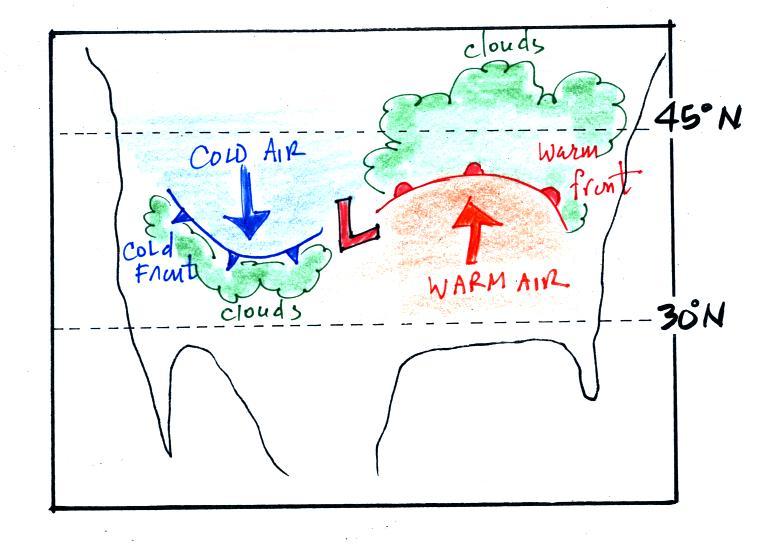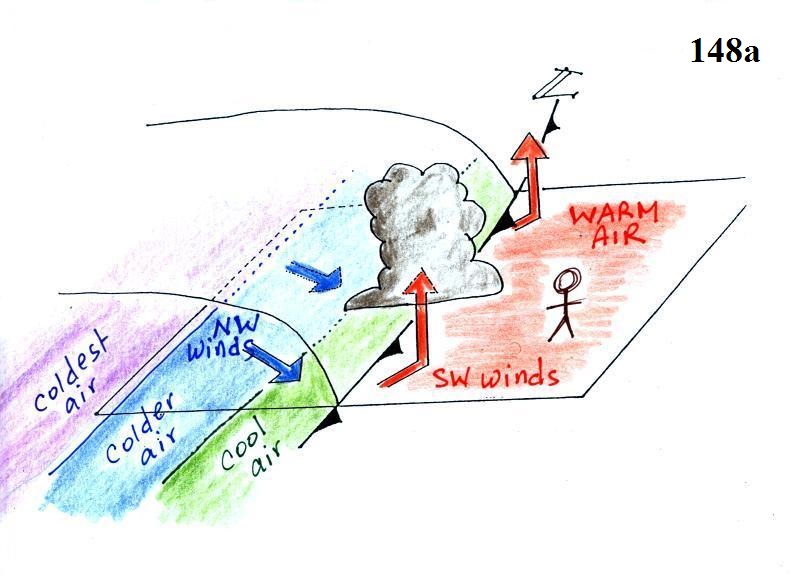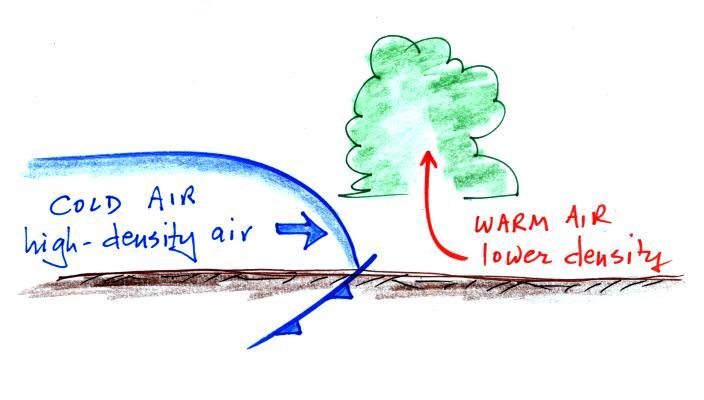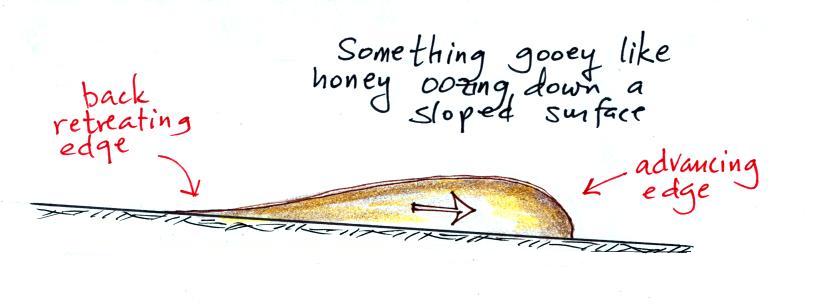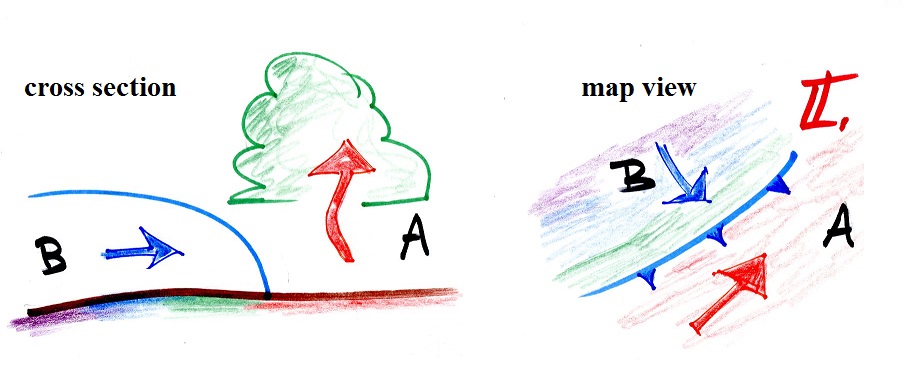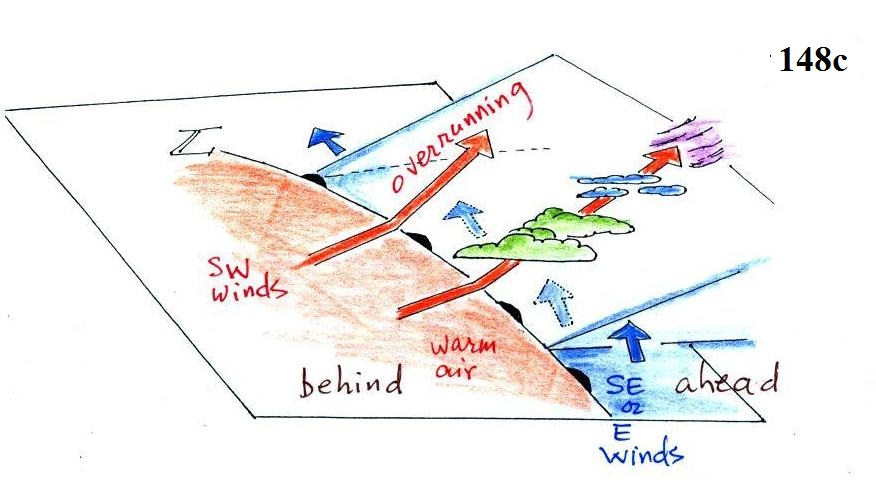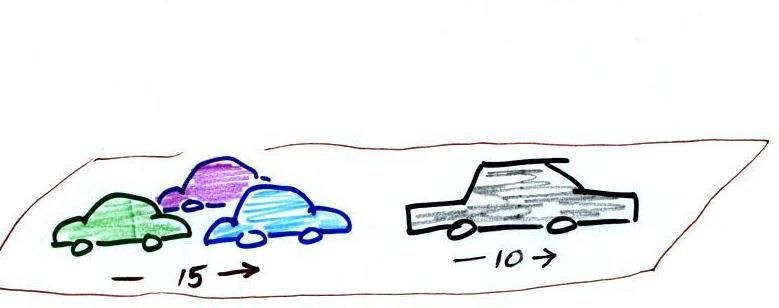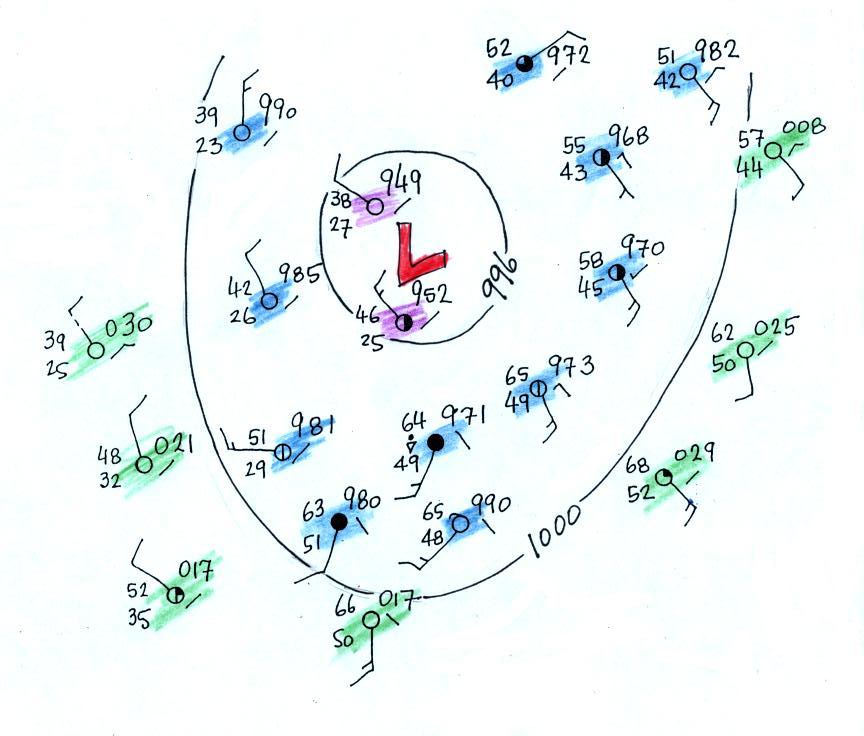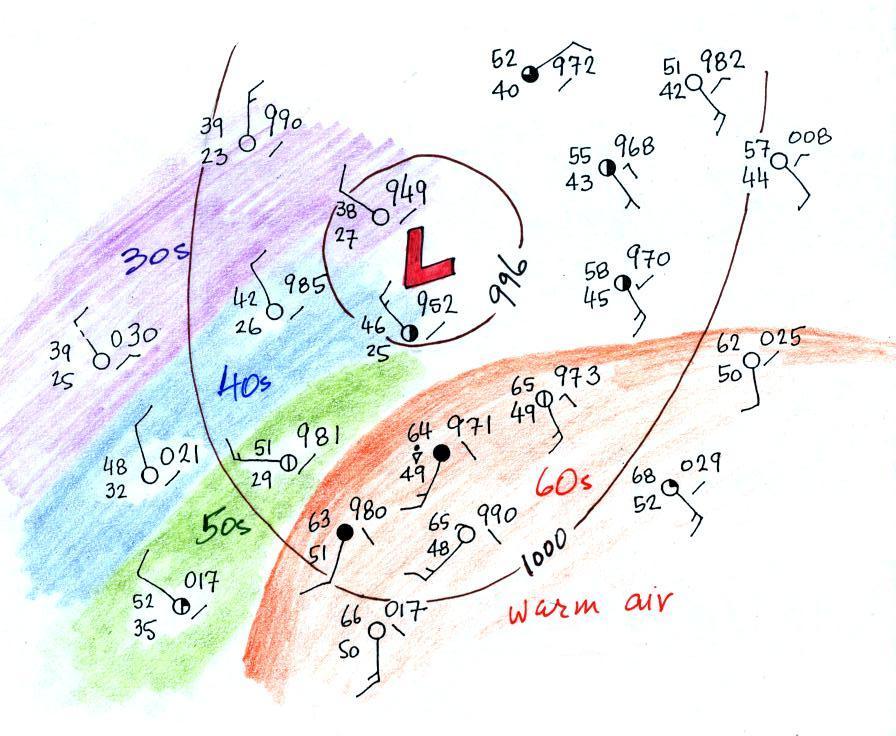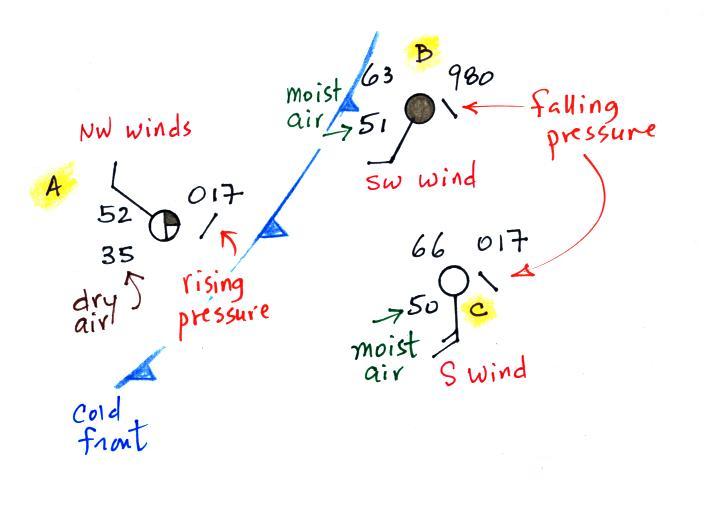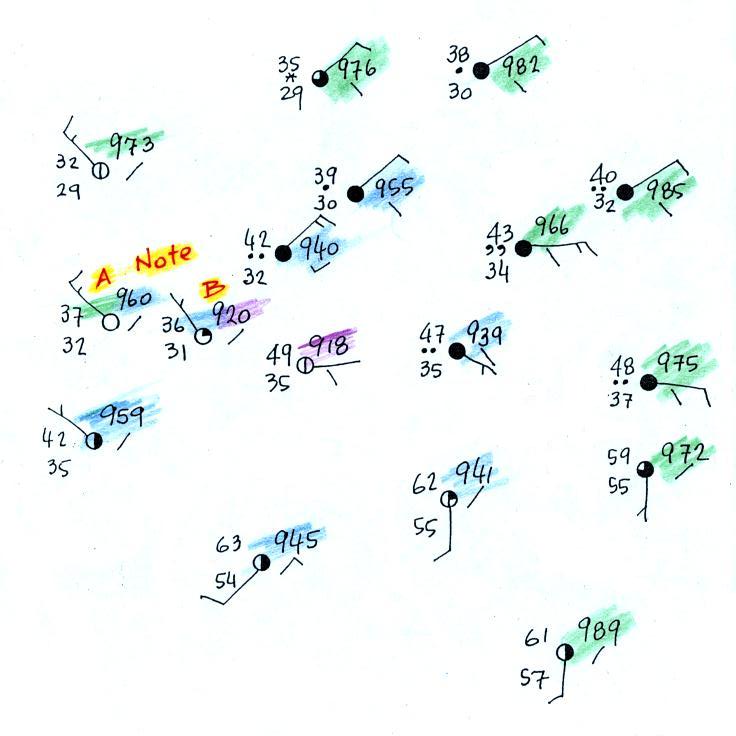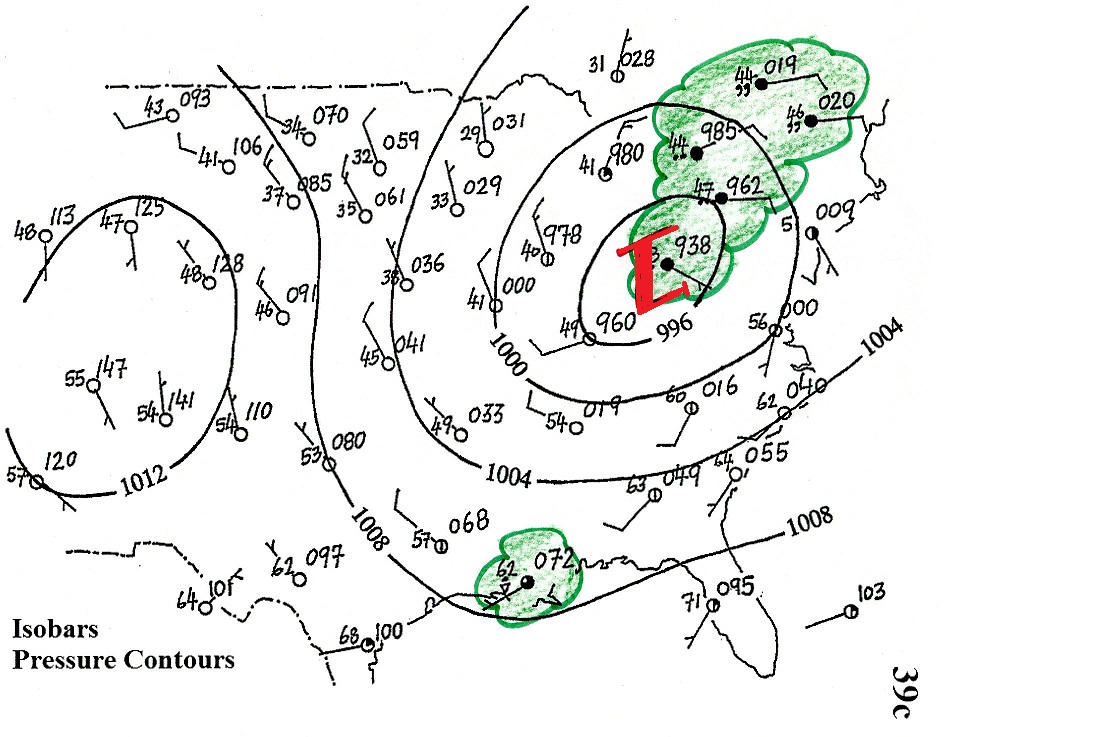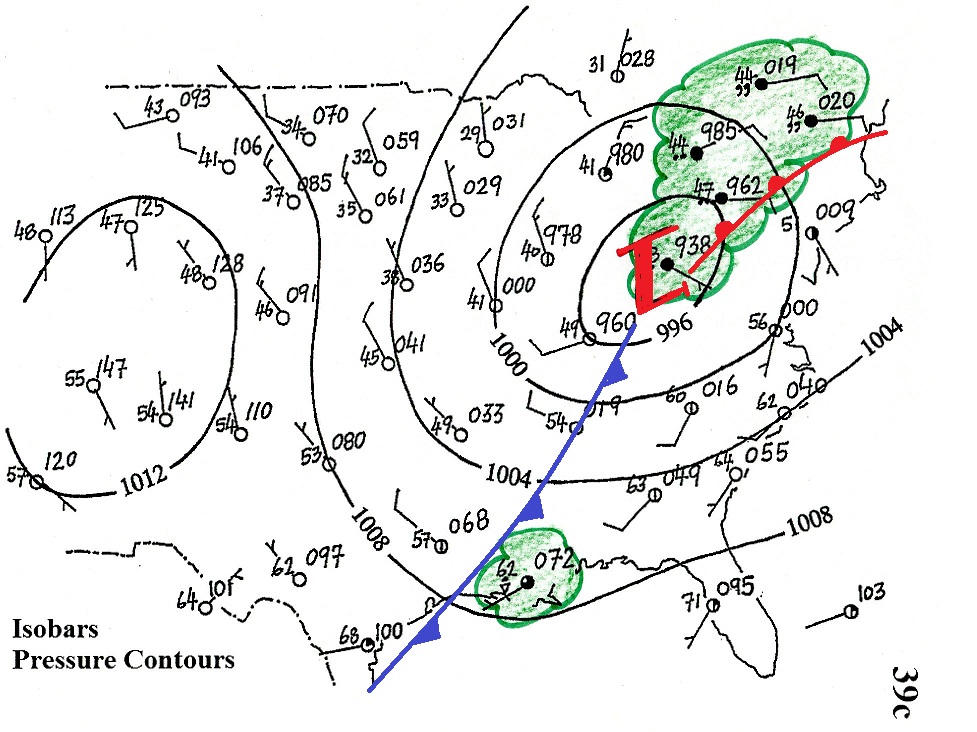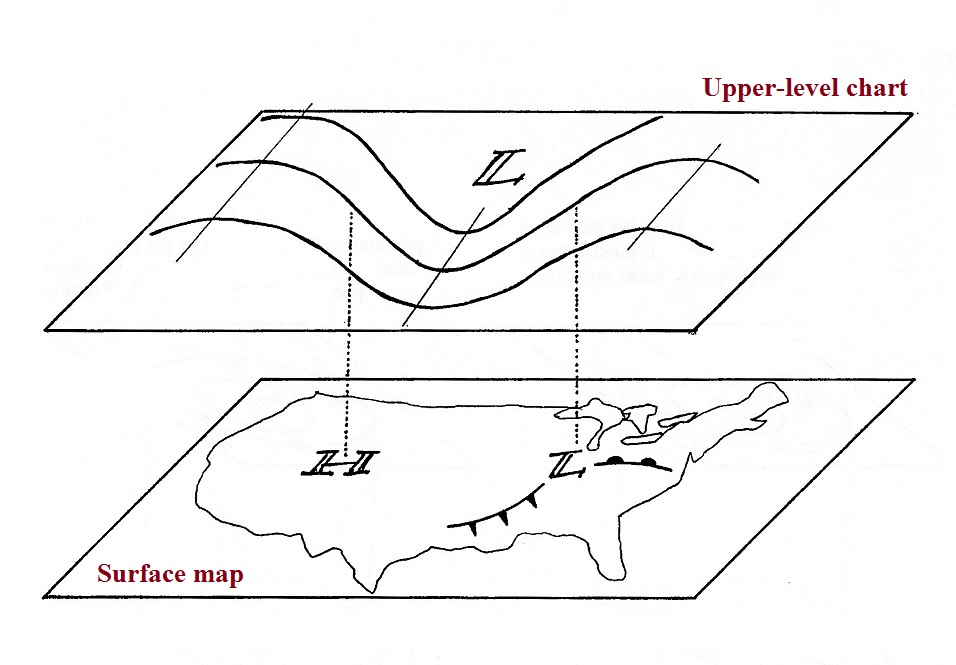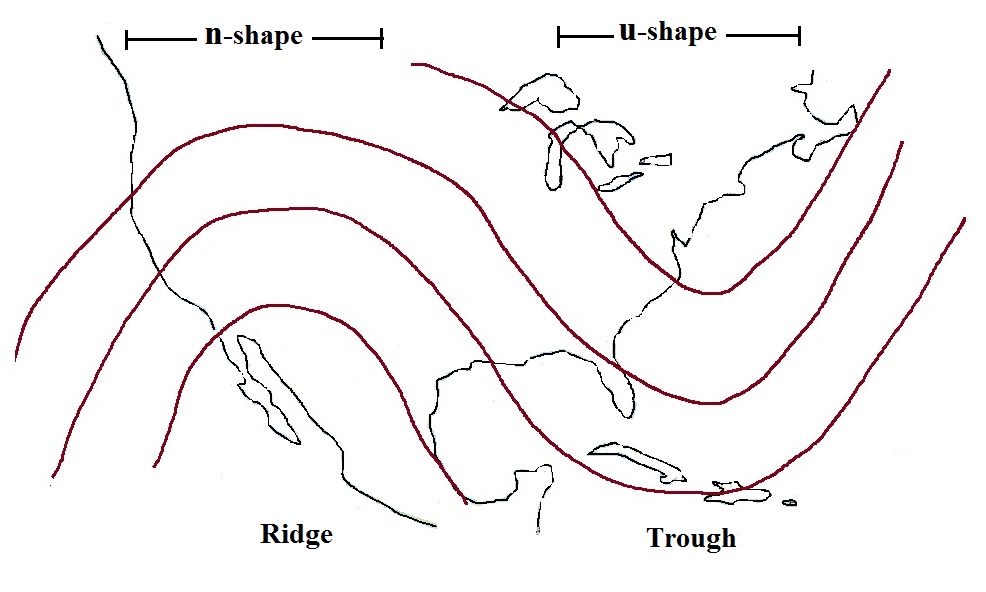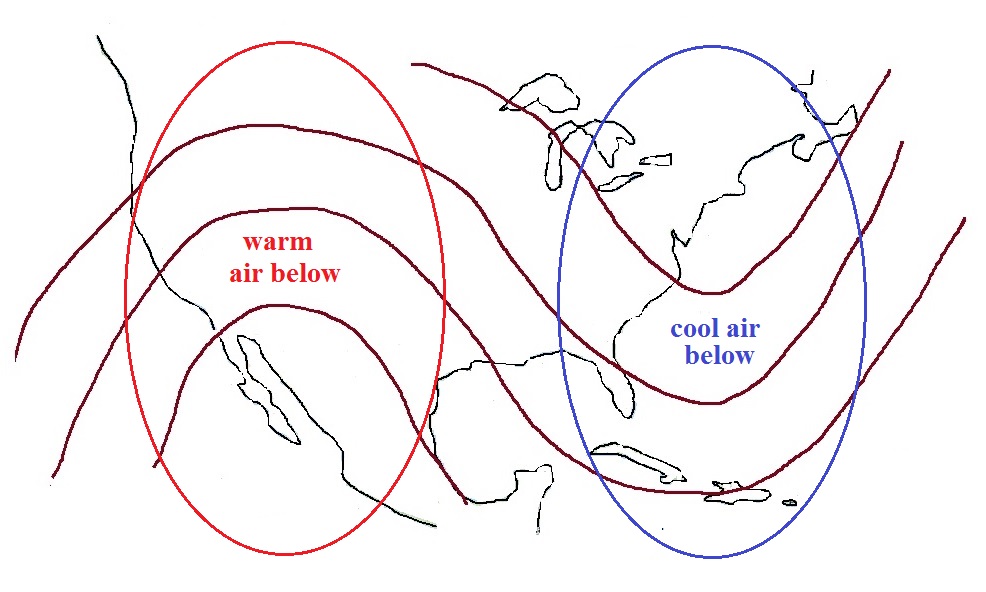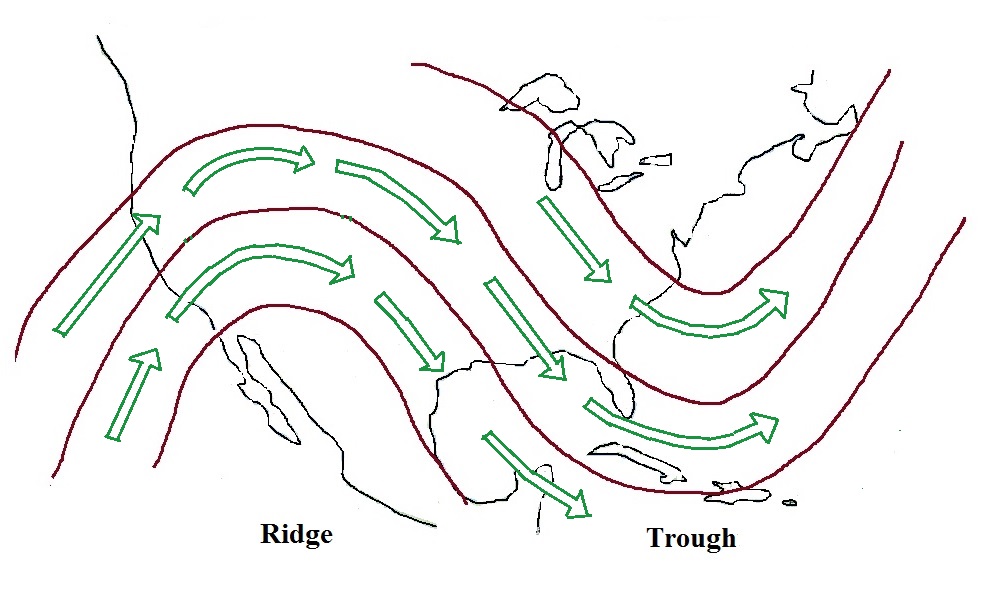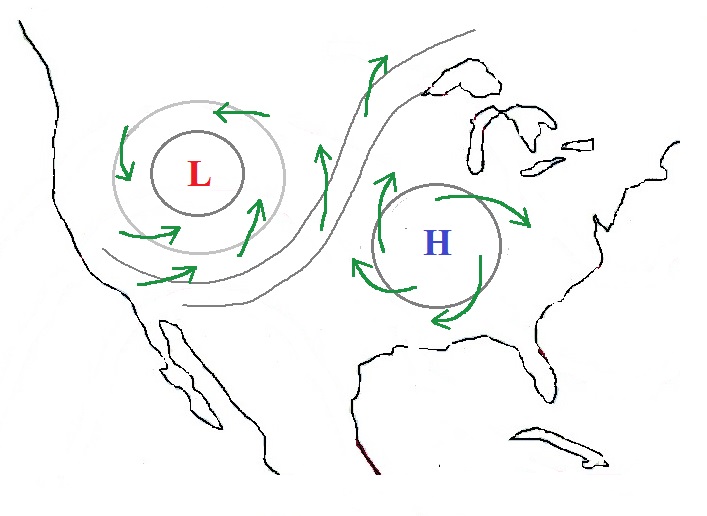Wednesday, September 25
Pages from the ClassNotes that we will be using
today are: page 40c,
page 40d, page 148a, page 148c, page 148b, page 148d, page 39c, page 41, and page 42
We first briefly review
material covered at the end of class on Monday.
Temperature patterns and fronts
The
pressure pattern causes the wind to start to blow; the wind
can then affect and change the temperature pattern.
The figure below shows the temperature pattern you would
expect to see if the wind wasn't blowing at all or if the wind
was just blowing straight from west to east. The bands
of different temperature are aligned parallel to the lines of
latitude. Temperature changes when moving from south to
north but not moving from west to east.

This picture gets a little more interesting if you place a
center of high or low pressure in the middle.
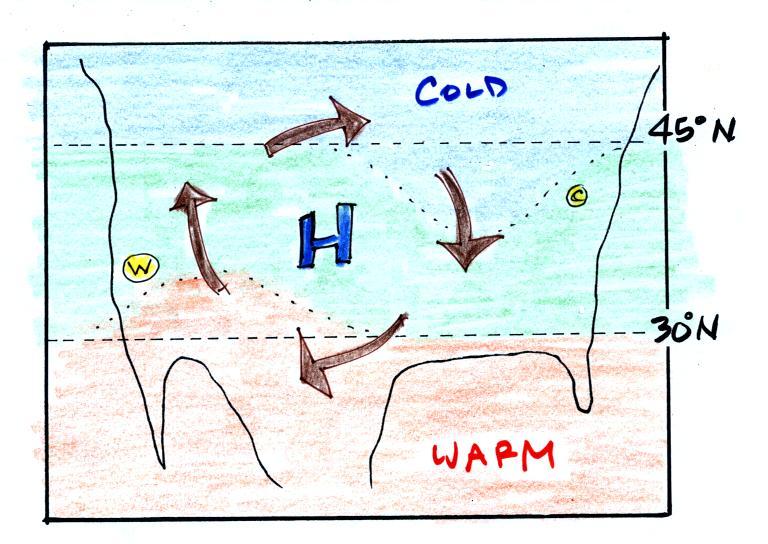
In the case of high pressure,
the clockwise spinning winds move warm air to the north on the
western side of the High. The front edge of this
northward moving air is shown with a dotted line (at Pt. W) in
the picture above. Cold air moves toward the south on
the eastern side of the High (another dotted line at Pt. C,
it's a little hard to distinguish between the blue and green
in the picture). The diverging winds also move the warm
and cold air away from the center of the High. Now you
would experience a change in temperature if you traveled from
west to east across the center of the picture.
The transition from warm to cold along the boundaries (Pts.
W and C) is spread out over a fairly long distance and is
gradual. This is because the winds around high pressure
diverge and blow outward away from the center of high
pressure. There is also some mixing of the different
temperature air along the boundaries.
Now we'll replace the H pressure center with a L pressure
center.
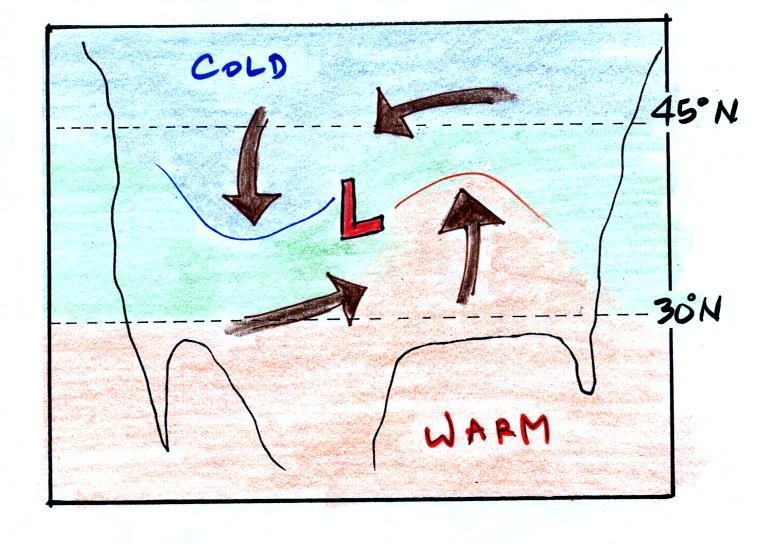
Counterclockwise winds move cold air toward the south on the
west side of the Low. Warm air advances toward the north
on the eastern side of the low. This is just the opposite
of what we saw with high pressure.
There's another difference - converging winds in the case of
low pressure will move the air masses of different temperature
in toward the center of low pressure. The transition zone
between different temperature air gets squeezed and
compressed. The change from warm to cold occurs in a
shorter distance and is sharper and more distinct. Solid
lines have been used to delineate the boundaries above. These
sharper and more abrupt boundaries are called fronts.
Warm and cold fronts, middle latitude storms (aka
extratropical cyclones)
A cold front is drawn at the front edge of the southward moving
mass of cold air on the west side of the Low. Cold fronts
are generally drawn in blue on a surface weather map. The
small triangular symbols on the side of the front identify it as a
cold front and show what direction it is moving.
A warm front (drawn in red with half circle symbols) is shown
on the right hand side of the map at front edge of the northward
moving mass of. A warm front is usually drawn in red and has
half circles on one side of the front to identify it and show its
direction of motion.
The fronts are like spokes on a wheel. The "spokes"
will spin counterclockwise around the low pressure center (the
axle).
Both types of fronts cause rising air motions.
Fronts are another way of causing air to rise. That's
important because rising air expands and cools. If the air
is moist and cools enough, clouds can form.
The storm system shown in the picture above (the Low together with
the fronts) is referred to a middle latitude storm or an
extra-tropical cyclone. Extra-tropical means outside the
tropics, cyclone means winds spinning around low pressure
(tornadoes are sometimes called cyclones, so are
hurricanes). These storms form at middle latitudes because
that is where air masses coming from the polar regions to the
north and the more tropical regions to the south can collide.
Large storms that form in the tropics (where this mostly just warm
air) are called tropical cyclones or, in our part of the world,
hurricanes.
3-dimensional structure of cold fronts
A
3-dimensional cross-sectional view of a cold front is
shown below. We've jumped to page
148a in the online version of the ClassNotes.
The person in the
figure is positioned ahead of an approaching
cold front. Time wise, it might be the day before
the front actually passes through. There
are 3 fairly important features to notice in this
picture.
1. The
front edge of the approaching air mass has a
blunt, rounded shape. A vertical slice
through a cold front is shown below at left.
Friction with
the ground causes the edge to "bunch up" and gives
it the blunt shape it has. You'd see
something similar if you were to pour something
thick and gooey on an inclined surface and watched
it roll downhill. Or, as
shown in class, you can lay your arm and hand on a
flat surface.
Slide your arm to the right.
Your fingers
will drag on the table surface and will curl up
and your hand will make a fist.
2. A cold front, the leading edge
of a cold air mass is kind of like a fist slamming into a
bunch of warmer air. Because it is denser, the cold
air lifts the warm air out of the way.
The cold dense air mass behind a cold
front moves into a region occupied by warm air. The
warm air has lower density and will be displaced by the
cold air mass. In some ways its analogous to a big
heavy Cadillac plowing into a bunch of Volkswagens.
At this point, just 15 to 20 minutes into today's class, we're in
a position to better appreciate a video recording of the cold
front passing through Tucson. The first video is a time
lapse movie of a cold front that came through Tucson on on Easter
Sunday morning, April 4, 1999. Click here
to see the cold front video (it may take a minute or two to
transfer the data from the server computer in the Atmospheric
Sciences Dept., be patient). Remember this is a time
lapse movie of the frontal passage. The front seems to
race through Tucson in the video, it wasn't moving as fast as the
video might lead you to believe. Cold fronts typically move
15 to 25 MPH.
The 2nd
video was another cold front passage that occurred on
February 12, 2012.
In the past I've had trouble playing the videos using Firefox
on the classroom computer. If that is the
case, you can right click on each link, then click on the Save
Link As... option, and choose to save to the Desktop.
Then double click on the icon on your desktop to view the
video. If you use
Chrome or Internet Explorer you should be able to watch the
videos.
3. Note
the cool, cold, colder bands of air behind
the cold front.
The warm air
mass ahead of the front has just been sitting
there and temperatures are pretty uniform
throughout. Cold fronts are found at the
leading edge of a cold air mass. The air
behind the front might have originated in
Canada. It might have started out very cold
but as it travels to a place like Arizona it can
change (warm) considerably. The air right
behind the front will have traveled the furthest
and warmed the most. That's the reason for
the cool,
cold,
and colder
temperature bands (temperature gradient) behind
the front. The really cold air behind a cold
front might not arrive in Arizona until 1 or 2
days after the passage of the front.
Weather
changes that precede and follow passage of
a cold front
Here are some of the specific weather changes
that might precede and follow a cold
front.
Weather
variable
|
Behind
|
Passing
|
Ahead
|
Temperature
|
cool, cold,
colder*
|
|
warm
|
Dew
Point
|
usually much
drier**
|
|
may be moist
(though that is often
not the case here in the desert southwest)
|
Winds
|
northwest
|
gusty winds (dusty)
|
from the southwest
|
Clouds,
Weather
|
clearing
|
rain clouds,
thunderstorms
in a narrow band along the front
(if the warm air mass is moist)
|
might see some high
clouds
|
Pressure
|
rising
|
reaches a minimum
|
falling
|
* as mentioned
above, the coldest air might follow passage of a cold front by
a day or two.
**nighttime temperatures drop much more quickly in dry air
than in moist or cloudy air. This is part of the reason
it can get very cold a day or two after passage of a cold
front.
Gusty winds and a shift in wind direction are often one of the
most obvious change associated with the passage of a cold
front in Tucson.
The pressure changes that precede and follow a cold front are
not something we would observe or feel but are very useful
when trying to locate a front on a weather map.
3-dimensional structure of warm fronts
We've learned a fair amount about cold fronts:
cross-sectional structure, weather changes that precede and
follow passage of a cold front, and how to locate a cold front
on a surface weather map. Now we have to
do the same for warm fronts. An
older version of page 148c is shown below, a somewhat cleaner
version is in the ClassNotes.
Warm air approaching and colliding with a cold air mass is like a
fleet of Volkswagens overtaking a Cadillac
The VWs are still lighter than the
Cadillac. What will happen when the VWs catch the
Cadillac?
They'll run up and over (overrun) the
Cadillac.
The same kind of thing happens along a warm front. Warm
air is overtaking some colder air that is also moving to the
right.
The approaching warm air is still less dense than the cold air and
will overrun the cold air mass.
There's one key difference between cold and warm front
boundaries
1. The back edge of a
retreating cold mass that the warm air overtakes has a much
different shape than the advancing edge. The advancing
edge bunches up and is blunt. The back edge gets
stretched out and has a more gradual ramp like shape.
You can use your hand and arm again.
You start with your fingers curled up
then move your arm and hand to the right.
As your arm moves to the
right, friction uncurls your fingers.
The warm air rises more slowly
and rises over a much larger area out ahead of the warm
front. A variety of cloud types form and spread out
over a large area ahead of the warm front. This is
an important difference between warm and cold fronts.
Weather changes
that precede and follow passage of a warm front
Here are the kinds of weather changes that usually precede
and follow passage of a warm front.
Weather
Variable
|
Behind
(after)
|
Passing
|
Ahead
(before)
|
Temperature
|
warmer
|
|
cool
|
Dew point
|
may be moister
|
|
drier
|
Winds
|
SW, S, SE
|
|
from the East or
SE, maybe even the S
|
Clouds,
Weather
|
clearing
|
|
wide
variety of clouds that may precede arrival of the front
by a day or two
clouds may produce a wide variety of types of
precipitation also
(snow, sleet, freezing rain, and rain)
|
Pressure
|
rising
|
minimum
|
falling
|
Locating a cold front on a weather map
In the next figure we
started with some weather data plotted on a surface
map using the station model notation. We'll try
to make a little more sense of this data and
eventually locate a cold front. Study this
example carefully because you will have an opportunity
to do a surface weather map analysis of your own and
will be able to earn some Extra Credit
points.
Step #1 - draw in some isobars and ocate the low
pressure center
In
some
respects fronts are like spokes on a
wheel - they rotate counterclockwise around
centers of low pressure. It makes sense
to first locate the center of low
pressure. To do that we
need
to draw in a few isobars and map out
the pressure pattern.
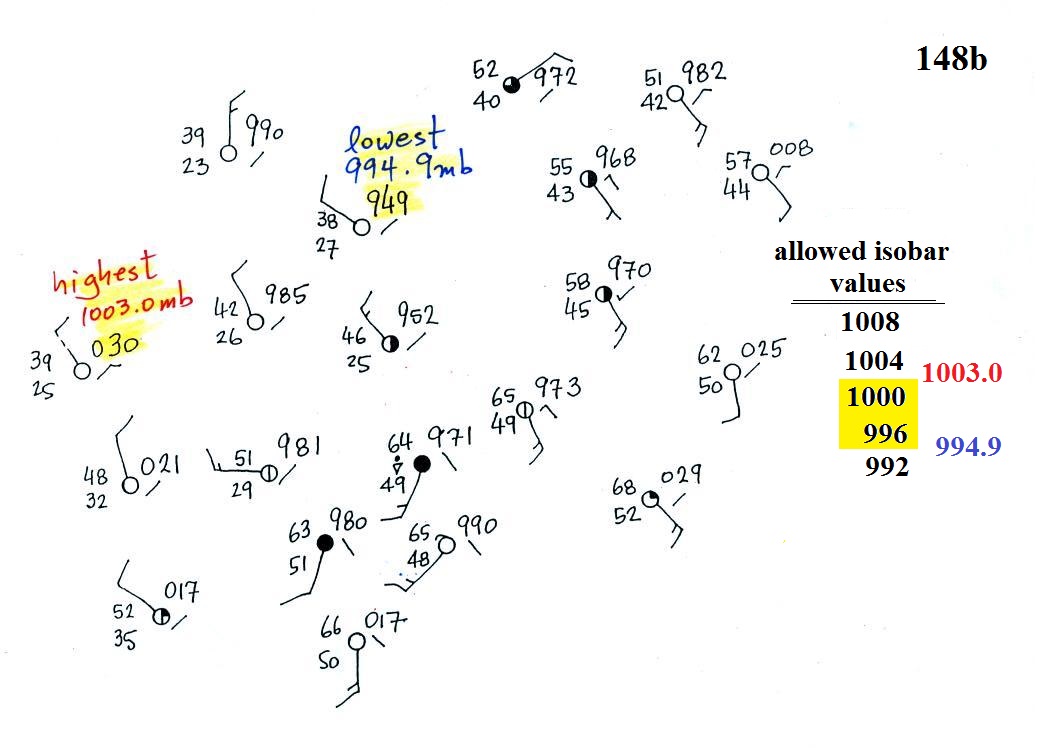
Isobars are drawn at 4 mb increments above and
below a starting value of 1000 mb. Some of the allowed
values are shown on the right side of the figure (992, 996, 1000,
1004, 1008 etc). The highest pressure on the map is
1003.0 mb, the lowest is 994.9 mb. You must choose from
the allowed list of isobar values and pick only the values
that fall between the high and low pressure values on the
map. Thus we only need to draw in 996 mb and 1000
mb isobars.
Step #1 cont'd
Color coding the plotted pressure values may be
helpful. In
the
figure below stations with pressures lower than
996 mb have been colored in purple.
These
will be enclosed by the 996 mb contour.
Pressures between 996 and 1000 mb have been colored blue. These
stations will lie outside the 996 mb contour but
inside the 1000 mb isobar. Finally stations with
pressures greater than 1000 mb have been colored green. The 1000
mb isobar will separate the blue stations from the
green stations.
End
of
Step #1
The map below shows the same picture
with the 996 mb and 1000 mb contours
drawn in (it is always a good idea to
label the isobars when you draw them
in).
Step
#2
- locate the warm air mass
The
next
step was to try to locate the
warm air mass in the picture.
I'll start with a new map for clarity
that keeps the isobars. The
colors now will represent different
air temperatures.
Temperatures
are
in the 60s in the lower right portion of the map;
this area has been circled in orange. Cooler air
to the west of the Low pressure center has also been
identified. Do the green, blue, purple (cool,
cold, colder) bands look familiar? Based on just
the temperatures we have a pretty good idea where a
cold front would be found.
Step #3 - draw in a tentative location for
the cold front
Locating and drawing in the cold front.
Step
#4
- double check the front location
We should
double check the front location using some of the
other weather changes (wind shift, dew point, pressure
change etc.) that precede and follow a cold front.
The air ahead of the front (Pts. B & C) is
warm, moist, has winds blowing from the S or SW, and the
pressure is falling. These are all things you would
expect to find ahead of a cold front.
Overcast skies are found at Pt. B. very near the front.
The air behind the front at Pt. A is colder, drier, winds are
blowing from the NW, and the pressure is rising. That is
just what you would expect behind a cold front. So our
location of the front looks pretty good.
Locating
a
warm front on a weather map
We need to finish our study of
surface weather maps by trying to located a warm front.
This is the map we will be working with
(see p. 148d in the ClassNotes). It's worth pausing
and noting that you really can't make any sense out of this
jumble of weather data at this point.
Step #1 - draw in some
isobars and locate the low pressure center
We'll start by drawing some isobars to map out the
pressure pattern. A partial list of allowed isobars is
shown at the right side of the map above (increments of 4 mb
starting at 1000 mb).
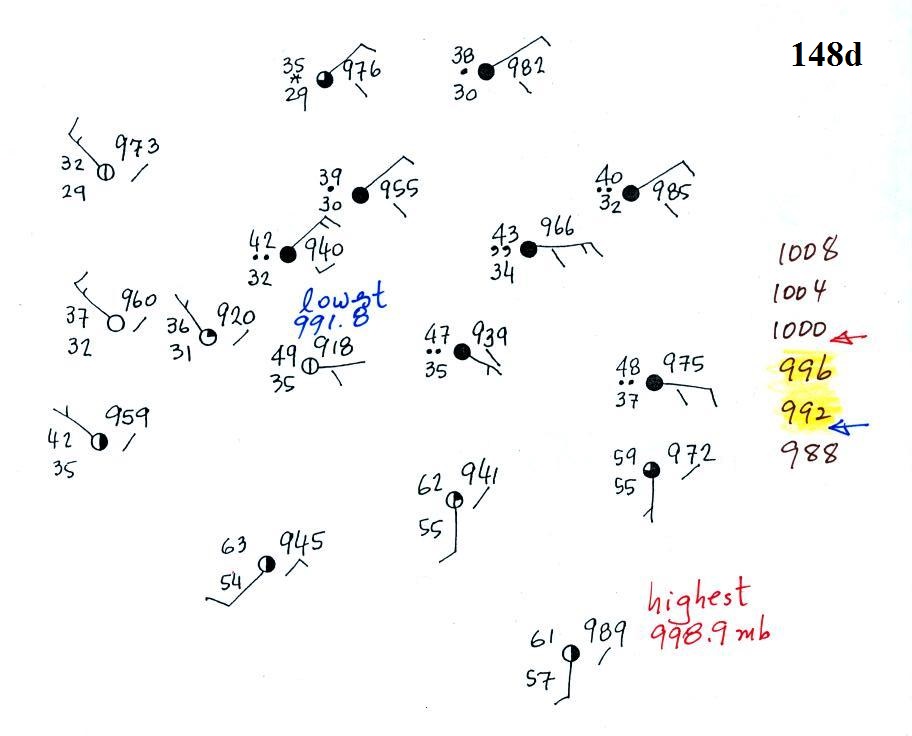
We've located located the highest and
lowest pressure values on the map. Then we choose
allowed isobar values that fall between these limits.
In this case we'll need to draw 992 mb and 996 mb isobars.
Here's the map with color coded pressures.
Pressures less than 992 mb are purple,
pressures between 992 and 996 mb are blue, and pressures greater
than 996 mb are green.
Note
that station B has a pressure of exactly 992.0 mb, the
992 mb isobar will go through that station. The 996 mb
isobar will go through station A because it has a pressure
of exactly 996.0 mb.
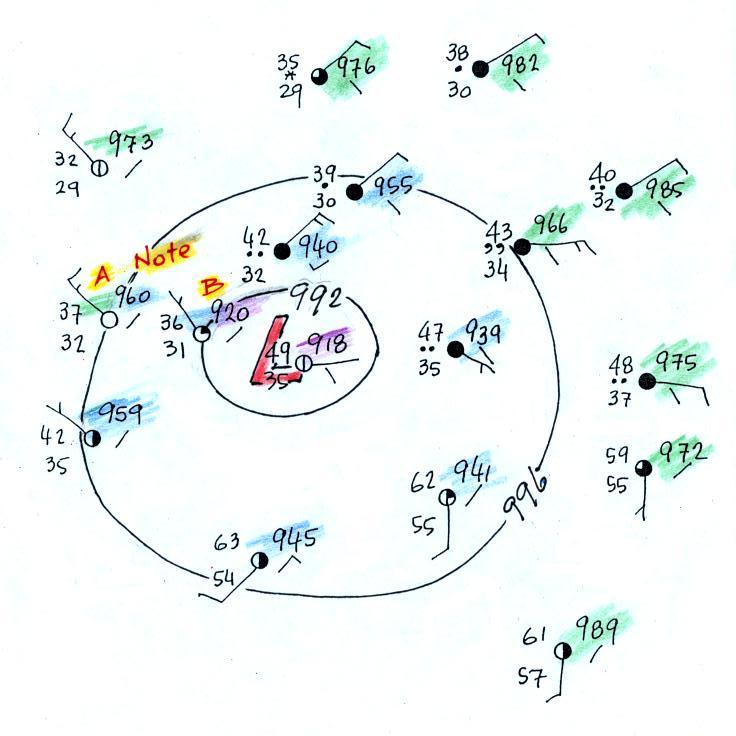
Here's the map with the isobars drawn
in. On the map below we use colors to locate the warm
and cooler air masses.
Step #2 - locate the warm air mass
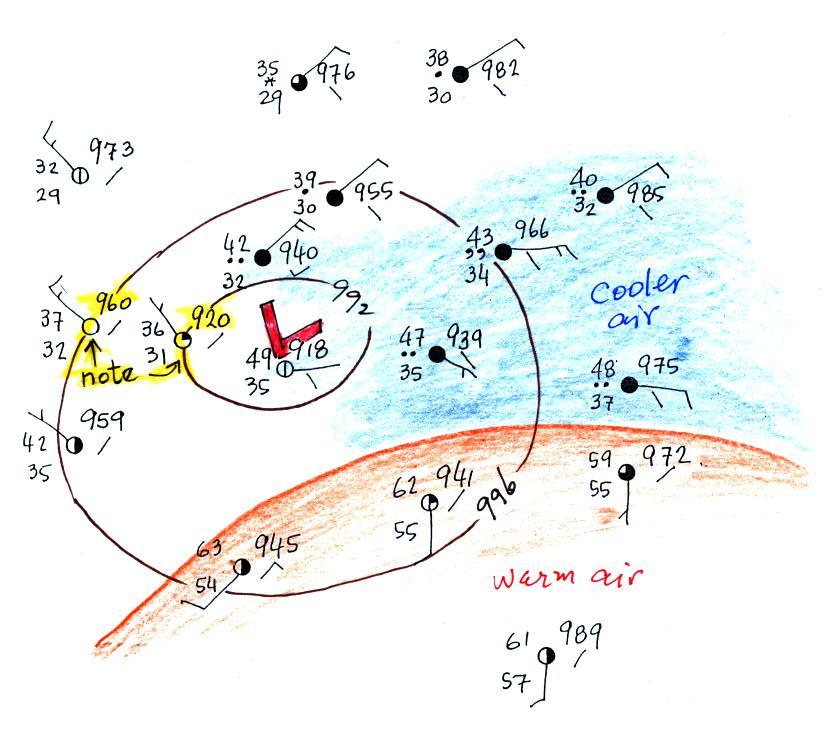
The warm air mass has been colored in orange.
Cooler air east of the low pressure center is blue.
Can you see where the warm front should go?
Step #3 - draw in a tentative warm
front location
Here's the map with a warm front drawn in
(the map was redrawn so that the edge of the warm
(orange) air mass would coincide with the warm
front).
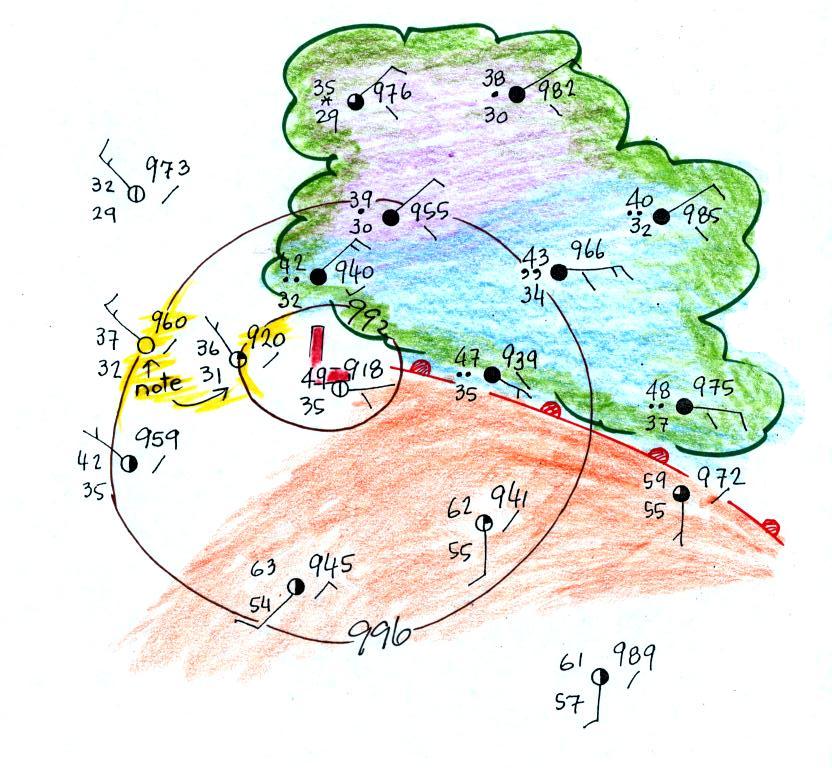
The change in wind directions was probably
more pronounced than the temperature change. Most of the
clouds outlined in green are probably being produced by the
warm front. You can see how more extensive cloud
coverage is with a warm front.
Step #4 - double check the
front location
Two of the stations near the right edge of the
picture and on opposite sides of the front are redrawn below.
The station north of the front has cooler and drier air,
winds are from the east, skies are overcast and light rain is
falling. The pressure is falling as the warm front
approaches. These are all things you'd expect to find
ahead of a warm front. Behind the front at the southern
station pressure is rising, the air is warmer and moister, winds
have shifted to the south and the skies are starting to clear.
In this case there is a Step #5 -
have a look at the rest of the surface map
Have a look at the
left, western, side of the map. There's pretty good
evidence of a cold front.

There's a big temperature change (low 60s to low 40s and 30s)
and a very noticeable wind shift (SW ahead of the cold front and
NW behind).
Lets go back to the surface map we began this section with
We were trying to figure out what was causing the cloudy &
rainy weather in the NE part of the map and why a rain shower was
being reported along the Gulf Coast. There's pretty clear
evidence of both a warm and cold front on this map. They're
shown in the figure below
The stormy weather in the NE appears to be largely caused by
the warm front. The rain shower along the Gulf Coast was
associated with a cold front.
Upper Level Charts - Basic Features
This section is undergoing some figure
improvement work.
We've already spent some time learning about surface
weather maps. Maps showing conditions at various altitudes
above the ground are also drawn. Upper level conditions can
affect the development and movement of surface features (and vice
versa).
In this first section we'll
just learn 3 basic facts about upper level charts. First
the overall appearance is somewhat different from a surface
weather map. The pattern on a surface map can be complex
and you generally find circular (more or less) centers of high
and low pressure (see the bottom part of the figure
below). You can also find closed high and low pressure
centers at upper levels, but mostly you find a relatively
simple wavy pattern like is shown on the upper portion of the
figure below (sort of a 3-dimensional view). The figure
below is on page
42 in the Class Notes.
A simple upper
level chart pattern is sketched below (a map view).
There are two basic features: wavy lines that dip southward
and have a "u-shape" and
lines that bend northward and have an "n-shape".
The following figure is on page
41 in the ClassNotes.
The u-shaped portion
of the pattern is called a trough. The n-shaped portion is called
a ridge.
Troughs are produced by large volumes of cool or cold
air (the cold air is found between the ground and the upper
level that the map depicts). The eastern half of the
country in the map above would probably be experiencing colder
than average temperatures. Large volumes of warm or hot
air produce ridges. We'll see why this is true in the
2nd part of the supplementary reading material.
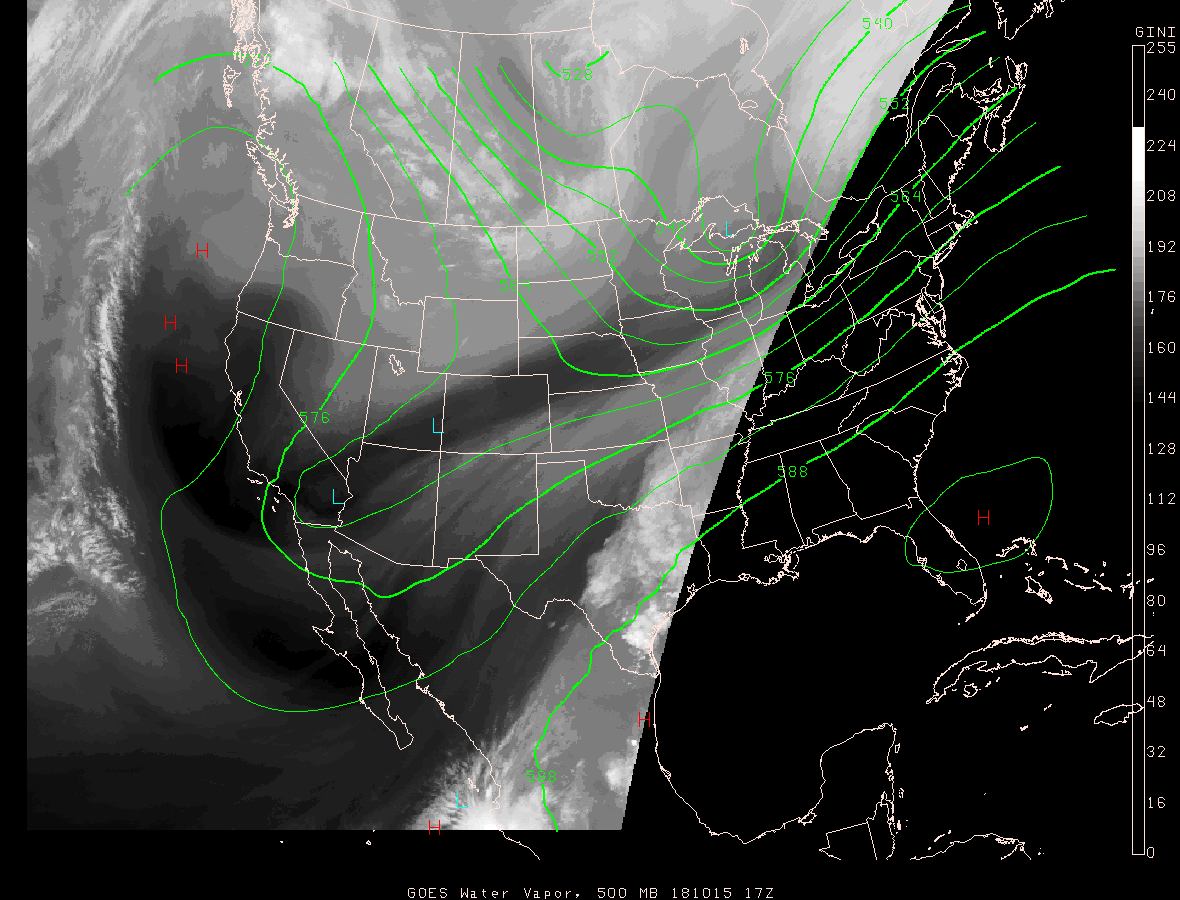
|
The 10 am MST 500 mb upper level chart
for Monday, Oct. 15, 2018. Note the trough
positioned over the western states.
This feature is partly responsible for the wetter- and
cooler-than-average weather we have been experiencing.
|
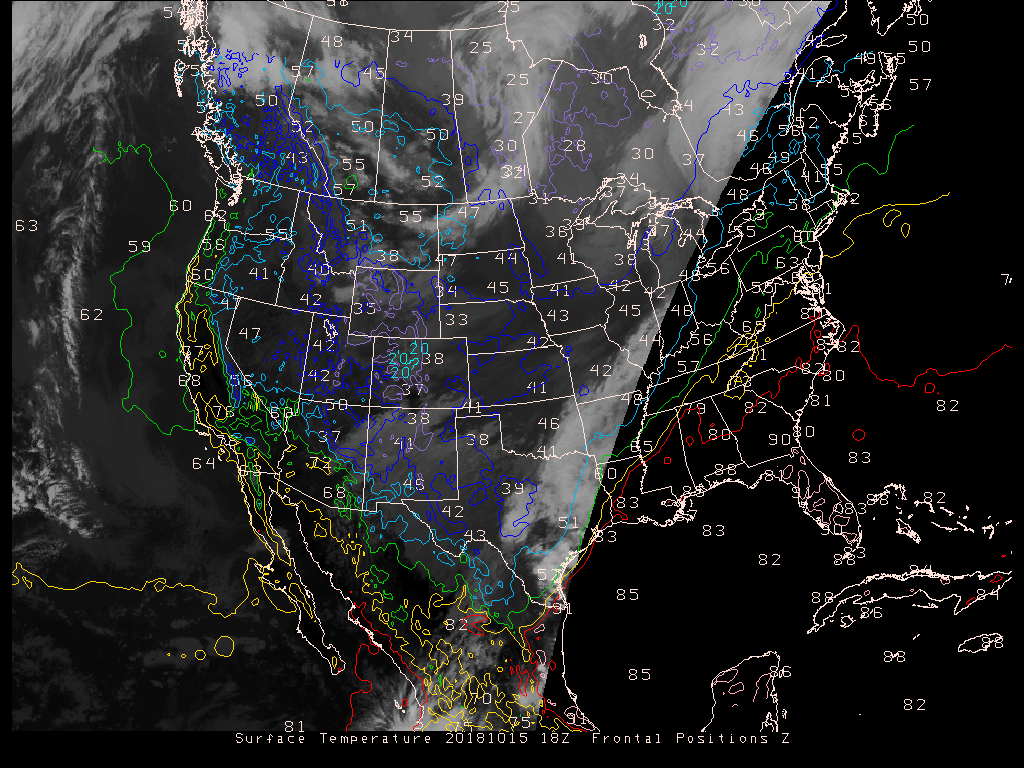
|
11 am surface temperatures for Monday,
Oct. 15, 2018. The western 2/3rds of the US are
under an upper level trough. Temperatures in
Arizona, New Mexico, and western Texas are in the 30s and
40s. The eastern 1/3rd of the country is under the
the edge of a ridge and is considerably warmer.
Temperatures in Mississippi, Alabama, and Georgia are in
the 80s.
|
We can begin to see how surface features can
influence the upper level pattern in the map below.
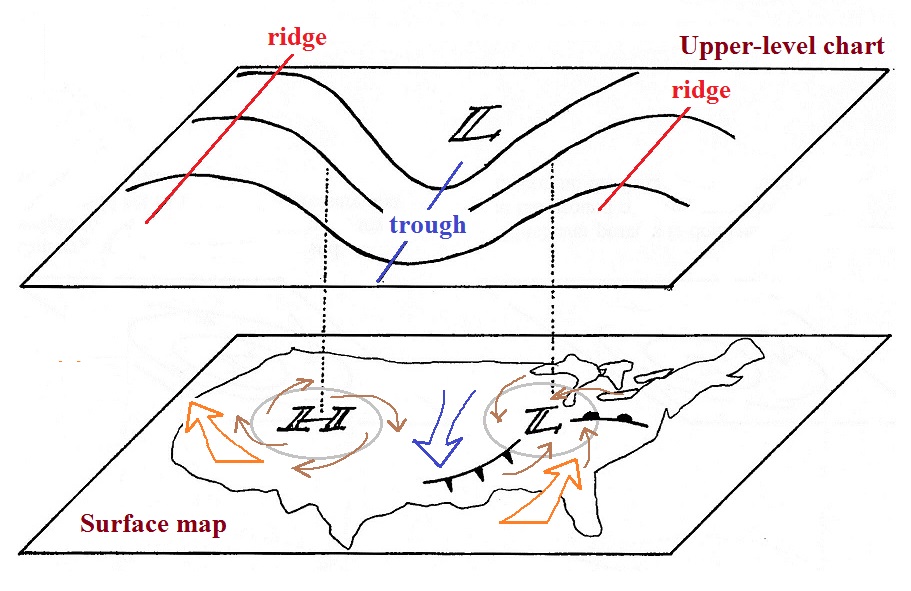
A surface center of low pressure is often found
east of an upper level trough. Surface high pressure is
often east of an upper level ridge. Note how the surface
winds in between the surface high and surface low are moving
colder air southward. This is directly below the upper
level trough axis. Warmer air is moving
northward to the east of the surface low and to the west of the
surface high. This warmer air is directly below upper
level ridges.
There is one last feature to be aware of.
The winds on upper level charts
blow parallel to the contour lines generally from west to
east. This is a little different from surface winds which
blow across the isobars toward low pressure. An example of
surface winds is shown below.
That's it for this section on the basic features of upper level
charts. Really all you need to be able to do is
1. identify troughs and ridges,
2. remember that troughs are associated with cold air & ridges
with warm air, and
3. remember that upper level winds blow parallel to the contour
lines from west to east.




